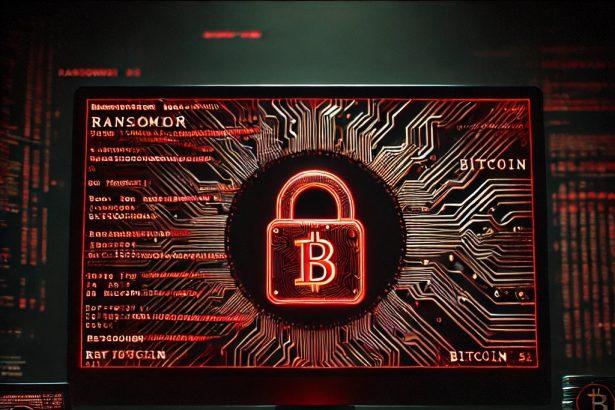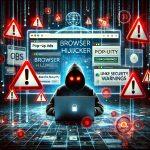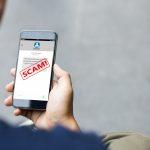Louis ransomware is a file-encrypting malware designed to lock victims’ files and demand a ransom for their decryption. Once the ransomware infiltrates a system, it encrypts files and appends the “.Louis” extension to them. For example, an image file named “1.jpg” becomes “1.jpg.Louis.” The attackers then leave a ransom note titled “Louis_Help.txt”, detailing how victims can contact the cybercriminals and pay for decryption.
The Louis ransomware also modifies the desktop wallpaper and displays a full-screen message before the user log-in screen, informing the victim of the attack. Notably, while the screen message warns about both encryption and data theft, the ransom note itself does not explicitly mention data exfiltration. This discrepancy raises concerns about double extortion tactics, where attackers threaten to leak stolen information if the ransom is not paid.
Threat Summary
| Attribute | Details |
|---|---|
| Name | Louis ransomware |
| Threat Type | Ransomware, Crypto Virus, Files Locker |
| Encrypted File Extension | .Louis |
| Ransom Note File Name | Louis_Help.txt |
| Cyber Criminal Contact | louisblanc@mailum.com, louisblanc@firemail.de |
| Detection Names | Avast (Win32:TrojanX-gen [Trj]), Combo Cleaner (Gen:Variant.Zusy.582289), ESET-NOD32 (A Variant Of Win32/Filecoder.OOO), Kaspersky (HEUR:Trojan-Ransom.Win32.Generic), Microsoft (Ransom:Win32/CylanceLoader.MKB!MTB) |
| Symptoms of Infection | Files are encrypted with the .Louis extension, ransom note appears (Louis_Help.txt), desktop wallpaper is changed, full-screen ransom message is displayed before login. |
| Damage | Files are permanently encrypted unless a decryption key is provided. Additional malware or trojans could be installed. |
| Distribution Methods | Malicious email attachments, phishing links, fake software downloads, cracked software, malvertising, infected torrents, trojanized software. |
| Danger Level | 🔴 High – Ransomware attacks can lead to data loss, financial damage, and potential data leaks. |
Ransom Note Message
The ransom note “Louis_Help.txt” contains the following text:
CRITICAL SECURITY ALERT
Your files have been encrypted
Before any payment, you will receive two decryption samples for free (sample files should not contain important documents).
Contact us:
📧 louisblanc@mailum.com
📧 louisblanc@firemail.de
Enter your ID in the email subject.
YOUR ID : –
READ THE FOLLOWING POINTS CAREFULLY.
- Please understand that this is not a personal matter but a business one; you are our customer, and we will treat you as a respectful customer.
- Do not play with encrypted files; make a backup copy of them before modifying or attempting to decrypt them.
- If you need an intermediary to negotiate with us, choose from reputable people and companies. We always provide the decryptor after payment.
- If you accidentally get an intermediary from the Internet, they may take money from you and not pay us. They may disappear or lie to you.
- We are experienced hackers, and we do not leave a trace. The police cannot help you. Instead, they will only ensure you never pay us, and you will lose your data.
Manual Ransomware Removal Process
Important: Manual removal is recommended only for experienced users, as incorrect actions can lead to data loss or incomplete removal of the ransomware. If unsure, consider the SpyHunter Removal Method for a guided, automated solution.
Step 1: Disconnect from the Internet
- Immediately disable Wi-Fi or unplug the Ethernet cable to prevent the ransomware from communicating with remote servers.
- This can prevent additional encryption or further infections.
Step 2: Boot into Safe Mode
For Windows Users
- Windows 10/11:
- Press Windows + R, type
msconfig, and press Enter. - Under the Boot tab, select Safe boot and check Network.
- Click Apply, then OK, and restart your PC.
- Press Windows + R, type
- Windows 7/8:
- Restart your PC and press F8 repeatedly before Windows starts.
- Select Safe Mode with Networking and press Enter.
For Mac Users
- Restart your Mac and hold the Shift key immediately after the startup chime.
- Release the key when the Apple logo appears.
- Your Mac will boot in Safe Mode.
Step 3: Identify and Terminate Malicious Processes
Windows
- Open Task Manager by pressing Ctrl + Shift + Esc.
- Look for unusual processes consuming high CPU or memory.
- Right-click on the suspicious process and select End Task.
Mac
- Open Activity Monitor (Finder > Applications > Utilities > Activity Monitor).
- Look for unknown or high-resource-consuming processes.
- Select the suspicious process and click Force Quit.
Step 4: Delete Ransomware Files
Windows
- Open File Explorer and navigate to:
C:\Users\[Your Username]\AppData\LocalC:\Users\[Your Username]\AppData\RoamingC:\Windows\System32
- Identify and delete suspicious files (randomly named or recently modified items).
- Clear temporary files:
- Press Windows + R, type
%temp%, and hit Enter. - Delete all files in the Temp folder.
- Press Windows + R, type
Mac
- Open Finder and select Go > Go to Folder.
- Type
~/Library/Application Supportand check for unfamiliar files or folders. - Remove unknown
.plistfiles from~/Library/LaunchAgents.
Step 5: Remove Ransomware Entries from Registry or System Settings
Windows
- Press Windows + R, type
regedit, and hit Enter. - Navigate to:
HKEY_CURRENT_USER\SoftwareHKEY_LOCAL_MACHINE\Software
- Identify and delete ransomware-related registry entries.
Mac
- Open System Preferences > Users & Groups.
- Select the Login Items tab and remove any unknown startup programs.
- Check
~/Library/Preferencesfor malicious settings.
Step 6: Restore System Using a Backup or Restore Point
Windows
- Press Windows + R, type
rstrui, and press Enter. - Choose a restore point from before the infection and proceed.
Mac
- Restart your Mac and enter macOS Utilities by holding Command + R.
- Select Restore from Time Machine Backup and restore a safe backup.
Step 7: Attempt to Decrypt Files
- Check No More Ransom (www.nomoreransom.org) for available decryption tools.
- If unavailable, restore files from backups.
Automated Ransomware Removal with SpyHunter
If manual removal is too complex or risky, SpyHunter offers a safer, automated method for detecting and removing ransomware.
Step 1: Download SpyHunter
- Get SpyHunter from the official Enigma Software website.
Step 2: Install SpyHunter
- Open the downloaded file (
SpyHunter-Installer.exeor.dmgfor Mac users). - Follow the installation prompts.
- Launch SpyHunter upon completion.
Step 3: Run a Full System Scan
- Click Start Scan Now to detect malware and ransomware.
- Wait for the scan to complete and review detected threats.
Step 4: Remove Detected Ransomware
- Click Fix Threats to remove identified ransomware components.
- SpyHunter will clean your system automatically.
Step 5: SpyHunter’s Custom Malware HelpDesk
- If ransomware persists, use SpyHunter’s Malware HelpDesk for custom malware fixes.
Step 6: Restore Files
- Use backups stored on external drives or cloud storage.
- If no backup is available, check No More Ransom for decryption tools.
Preventing Future Ransomware Attacks
- Keep backups: Use cloud storage or an external hard drive.
- Install a reliable security tool: SpyHunter offers real-time protection against malware.
- Enable Windows Defender or Mac security features for additional protection.
- Avoid phishing emails and unknown attachments.
- Regularly update Windows, macOS, and installed applications.
Conclusion
Louis ransomware is a severe cybersecurity threat that encrypts files, demands ransom payments, and possibly engages in double extortion tactics. Victims are strongly advised against paying the ransom, as cybercriminals often fail to provide decryption tools even after receiving payment. Understanding how ransomware spreads is essential for preventing infections and protecting sensitive data.




